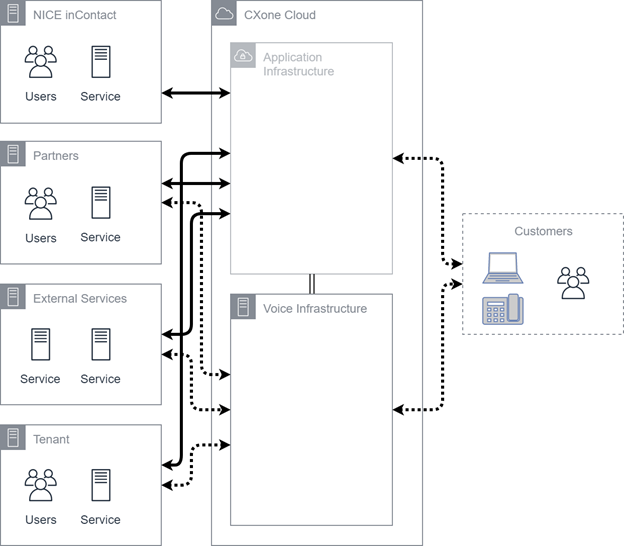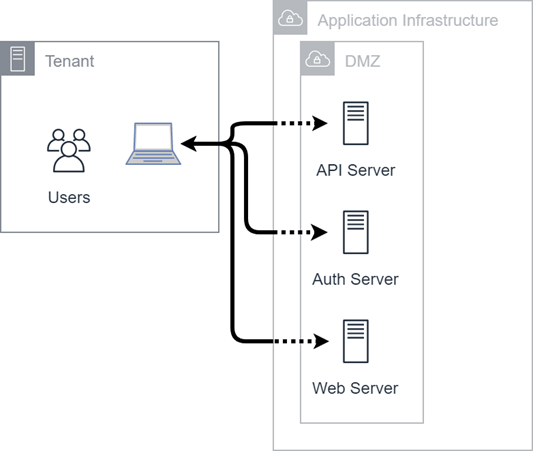Data flows between CXone Mpower applications, internal and external servers, contacts, and your
Information Flow Direction
The diagrams on the pages in this section represent external connectivity data flows. The arrows shown in these diagrams represent the flow of information. They do not represent where the information flow starts. Almost all flows go both ways, even though the connection may originate from one location. For example, most API![]() Application Programming Interface. Allows you to automate certain functionality by connecting your CXone Mpower system with other software. flows are RESTful and always originate with the client. The information exchanged through the API can put information into and take information out of the CXone Mpower system. So, the arrow goes both ways.
Application Programming Interface. Allows you to automate certain functionality by connecting your CXone Mpower system with other software. flows are RESTful and always originate with the client. The information exchanged through the API can put information into and take information out of the CXone Mpower system. So, the arrow goes both ways.
Boundary Definition and Encryption
There are several types of boundaries represented in the diagrams on the pages in this section:
- Primary Division: A line between public and private networks.
- Edge Network: Suggest: A network not entirely public or private. The use of public cloud systems introduces this.
- Layered Application: Related to public and private networks. They include public, DMZ, and internal areas.
- Public Cloud Services: Can exist on the edge of public and DMZ or internal network environments.
Boundary devices or services may stop encryption at the edge of the public network on the primary division. In public clouds, this may also include edge networks. The diagrams show changes in encryption by changing the line style from solid to dashed. A solid line represents an area where data is encrypted. A dashed line represents an area where data is unencrypted. Depending on the cloud infrastructure, this may result in unencrypted traffic going over edge networks.
CXone Mpower Channels
CXone Mpower offers several different channels![]() Various voice and digital communication mediums that facilitate customer interactions in a contact center. for
Various voice and digital communication mediums that facilitate customer interactions in a contact center. for ![]() The person interacting with an agent, IVR, or bot in your contact center.. Channel transcripts, like native chat or voice, are not shared.
The person interacting with an agent, IVR, or bot in your contact center.. Channel transcripts, like native chat or voice, are not shared.
Storage, when shown in the diagrams on the pages in this section, is either:
-
CXone Mpower storage in data centers.
In the diagrams, Cloud Storage uses
In almost all cases, a message broker is being utilized. They are not shown in the diagrams and don't transfer sensitive information.
Support for transcript encryption of sensitive data varies based on the channel used:
-
-
Phone: supported.
-
Chat: supported.
-
Classic Email: supported.
-
Cloud Email: supported.
-
SMS: supported.
-
Voicemail: supported.
-
Work Item: supported.
-
Callback: supported.
-
Personal Connection, Phone: supported.
-
Advanced Chat/Co-Browse: not supported.
-
-
-
Phone: supported.
-
Chat: supported.
-
Classic Email: supported.
-
Cloud Email: not supported.
-
SMS: not supported.
-
Voicemail: not supported.
-
Work Item: not supported.
-
Callback: not supported.
-
Personal Connection, Phone: not supported.
-
Advanced Chat/Co-Browse: not supported.
-
General CXone Mpower Components
The diagram below shows general CXone Mpower service components and their relationships. The CXone Mpower Cloud:
-
Encompasses the entire CXone Mpower infrastructure for production systems.
-
Equally represents the FedRAMP and non-FedRAMP systems.
-
Is divided into two main components: the application infrastructure and the voice infrastructure.
The application infrastructure could live in the private or public cloud infrastructure depending on the original implementation. The voice infrastructure is almost exclusively provided through private cloud infrastructure. This is due to the performance requirements of voice equipment.
Also shown are a variety of different external networks, including:
-
CXone Mpower corporate systems.
-
Partner services.
-
External networks.
-
External services.
These are used to provide core functionality and
The connectivity shown in the diagram represents aggregated information. In all cases, both personal and non-personal information may be transmitted. CXone Mpower does not analyze ![]() Various voice and digital communication mediums that facilitate customer interactions in a contact center.. This internal data is mostly carried over channels governed by TLS ciphers. Some internal hops may not have TLS configuration. Internal data is not said to be encrypted in every case.
Various voice and digital communication mediums that facilitate customer interactions in a contact center.. This internal data is mostly carried over channels governed by TLS ciphers. Some internal hops may not have TLS configuration. Internal data is not said to be encrypted in every case.
This communication is shown in more detail in the diagrams on other pages in this section.

Common Product Flows
Most flows between users and the CXone Mpower Cloud occur between a web browser and the application infrastructure. These flows use standard web protocols utilizing TLS algorithms. This communication applies to all products that list port 443 with the destination of the application infrastructure. Port 80 may also be listed. Many of these applications use other services of the environment, but there are three basic targets:
-
Authentication servers.
-
Web servers.
These targets are all technically web servers, but their functions and endpoints (hostnames) are distinct. The endpoints live in a demilitarized zone (DMZ) and use a standard-tiered application model.
The diagram below covers the following applications:
-
Central (except SFTP).
-
Direct Data Access
As shown in the diagram below, API and web server communication may contain personal information. Authentication flows may contain personal data in the token responses.


